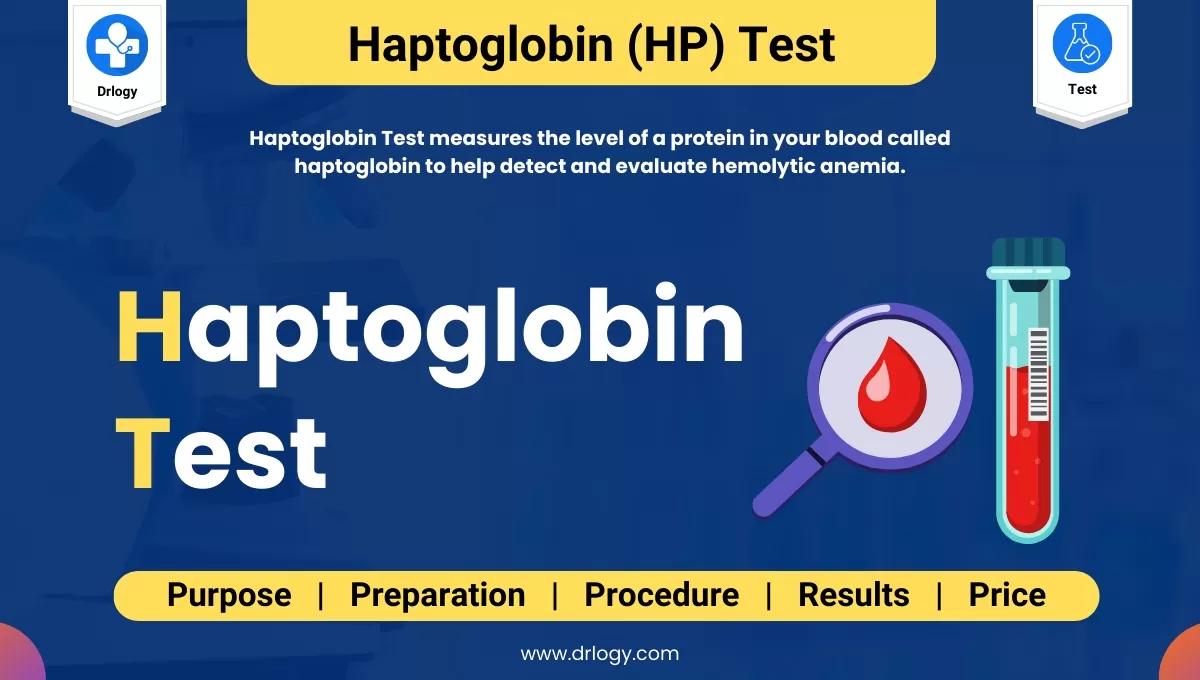
The Haptoglobin test measures the level of haptoglobin in the blood, providing information about hemoglobin breakdown, hemolytic anemia, or other related conditions.
Here are the basic details for the Haptoglobin Test.
| Also Known As | HP Test |
| Type | Blood Test |
| Purpose | Check haptoglobin levels in the blood |
| Sample Type | Blood |
| Preparation | No Special Preparation Required |
| Fasting | No |
| Gender | All |
| Age-Group | Any |
| Normal Value | 41-165 mg/dL |
| Reporting Time | 1 - 2 Days |
| Cost | 1100 - 3780 INR* |
*Price range may vary as per location, lab type, and procedure of lab test.
Measures the level of haptoglobin in the blood.
Short Summary
- Haptoglobin is a protein that binds to free hemoglobin.
- Haptoglobin levels can indicate hemolysis or inflammation.
- Certain genetic variations can affect haptoglobin levels.
Here is the basic purpose of the Haptoglobin Test.

Here is the essential preparation for the Haptoglobin Test.
Short Summary
Proper preparation includes informing the doctor, following fasting instructions, and sharing relevant medical history.
Here is the basic procedure of the Haptoglobin Test.
It is important to interpret haptoglobin test results in conjunction with other clinical findings and medical history to determine the underlying cause.


Haptoglobin Normal Test Report PDF Format

Haptoglobin Abnormal Test Report PDF Format
Here's the normal range for Haptoglobin:
| Haptoglobin Level | Normal Range |
|---|---|
| Adults | 41 - 165 mg/dL |
| Children | 30 - 200 mg/dL |
| Newborns | 50 - 250 mg/dL |
Here is the basic interpretation of the Haptoglobin test.
| Haptoglobin Level | Interpretation |
|---|---|
| Low | Associated with hemolysis or liver disease |
| Normal Range | Indicates normal haptoglobin levels |
| High | May be seen in inflammation or infection |
Here are potential causes for high levels of Haptoglobin.
| Cause | Description |
|---|---|
| Inflammation or infection | Elevated levels can be seen in response to infection or inflammation. |
| Tissue damage | Increased haptoglobin production due to tissue injury or trauma. |
| Chronic liver disease | Liver dysfunction can lead to elevated haptoglobin levels. |
| Hemolytic anemia | Increased breakdown of red blood cells triggers haptoglobin release. |
| Rheumatoid arthritis | Inflammatory condition associated with elevated haptoglobin levels. |
Here are potential causes for low levels of Haptoglobin.
| Cause | Description |
|---|---|
| Hemolytic anemia | Decreased haptoglobin production due to rapid red blood cell breakdown. |
| Liver disease | Impaired liver function can result in decreased haptoglobin levels. |
| Malnutrition | Inadequate intake of nutrients affecting haptoglobin synthesis. |
| Genetic disorders | Certain inherited conditions can cause low haptoglobin levels. |
| Hemoglobinuria | Presence of hemoglobin in the urine leads to haptoglobin depletion. |
Short Summary
High haptoglobin levels indicate inflammation, infection, or liver disease, while low levels suggest anemia or red blood cell breakdown.
Here are the specimen requirements for the Haptoglobin Test.
| Specimen | Blood or Serum |
| Volume | 2 ml |
| Container | Lavender-top (EDTA) tube |
The haptoglobin test is safe and generally well-tolerated.
Here are some possible limitations of the Haptoglobin Test.
Here is the potential risk factor of the Haptoglobin Test.
Here are Doctor's recommendations or consult a specialist after Haptoglobin Test.
| Result | Doctor to Visit | Reason |
|---|---|---|
| High | Hematologist | Potential hemolytic disorders |
| Normal | General Practitioner | No significant abnormalities found |
| Low | Hematologist | Potential liver or kidney disease |
Here are the estimated Haptoglobin Test Price in India with different top cities:
| City | Price Range (INR)* |
|---|---|
| Mumbai | 1100 - 3780 |
| New Delhi | 1200 - 3700 |
| Bangalore | 1100 - 3500 |
| Hyderabad | 1200 - 3500 |
| Kolkata | 1200 - 3700 |
| Pune | 1100 - 3780 |
| Lucknow | 1200 - 3700 |
| Noida | 1100 - 3780 |
| Surat | 1200 - 3700 |
| Gurugram | 1100 - 3780 |
| Patna | 1200 - 3700 |
| Chennai | 1100 - 3780 |
| Jaipur | 1200 - 3700 |
| Ahmedabad | 1100 - 3780 |
*Prices are approximate and vary depending on a specific laboratory or healthcare facility.
Summary
Overall, The Haptoglobin test is a safe method to assess haptoglobin levels in the blood. Also check Drlogy Test for detailed information about all medical tests for patients, doctors, scholers and medical students.
Reference
A haptoglobin test is a medical test that measures the levels of haptoglobin, a protein produced by the liver, in the blood.
A haptoglobin test can help diagnose and monitor conditions associated with hemolysis, such as hemolytic anemia and certain liver diseases.
A haptoglobin test involves a simple blood draw, usually from a vein in the arm.
Low haptoglobin levels may suggest conditions involving increased red blood cell destruction, such as hemolytic anemia or certain liver diseases.
10M+
Patients
22000+
Doctors
20000+
Hospitals/Labs
Drlogy Testclose
Copyright © 2025 Drlogy. All rights reserved.